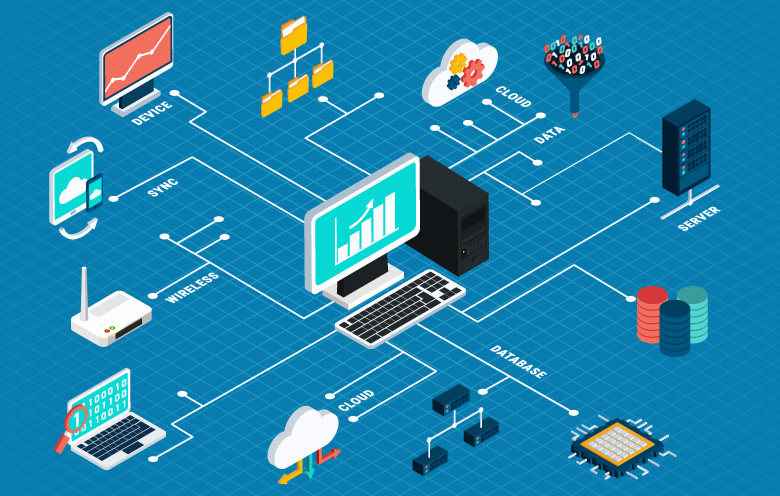Top 5 Benefits of Implementing Managed IT Services for Your Business
6 min read
The practice of contracting out specific IT tasks to a third-party company referred to as a Managed Services Provider, is referred to as the benefits of managed It services. These services can range from infrastructure management, network monitoring, and cybersecurity, to cloud solutions and helpdesk support. The main objective is to relieve businesses of their daily operational burden so they can concentrate on their core competencies while the MSP makes sure their IT environment is reliable secure and up-to-date.
Managed IT services offer several benefits to businesses, including improved efficiency, reduced downtime, cost reduction, and talent. Businesses that outsource their IT services to a third-party vendor allow their IT specialists to handle the IT department while they concentrate on their core business activities. Managed IT companies guarantee prompt and effective problem-solving by providing dependable and expeditious service.
Reduce IT Operating Costs
Reducing IT operating costs is a crucial aspect of managing a business’s technology infrastructure. By implementing cost-saving measures, organizations can improve their financial performance and allocate resources to other important areas. Here are some ways to reduce IT operating costs:
Cloud Computing: Cloud computing allows businesses to reduce their on-premises infrastructure costs by using virtualized resources provided by third-party providers. Since companies only pay for the resources they utilize, this can result in significant cost savings.
Automation: Automating repetitive tasks can help reduce labour costs and improve efficiency. For example, automating software updates, backups, and system monitoring can free up IT staff to focus on more strategic tasks.
Virtualization: Virtualization allows businesses to run multiple virtual machines on a single physical server, reducing hardware costs and improving resource utilization.
Managed Services: Outsourcing IT functions to managed service providers can help reduce costs by leveraging economies of scale and specialized expertise. This can include managed network services, managed security services, and managed infrastructure services.
Open Source Software: Open source software can provide a cost-effective alternative to commercial software. Many open-source solutions offer similar functionality to their commercial counterparts but without licensing fees.
IT Asset Management: Implementing an IT asset management strategy can help businesses track their hardware and software assets, identify underutilized resources, and optimize their IT infrastructure.
Energy Efficiency: Improving energy efficiency can help reduce the costs of operating and cooling IT equipment. This can include using energy-efficient servers, optimizing data centre layouts, and implementing power management policies.
Training and Development: Investing in training and development can help IT staff become more efficient and effective, reducing the need for costly external consultants and improving overall productivity.
Streamline IT Asset Management
Streamlining IT asset management is crucial for organizations to efficiently track, monitor, and manage their technology assets. This process involves the centralized maintenance and tracking of technology assets to account for and monitor expensive technology with ease. It includes managing the repair, recovery, retirement, and renewal of telecommunications assets, as well as streamlining inventory through a central inventory portal.
To streamline IT asset management, a five-step approach can be adopted:
Identify the assets you intend to track: This involves acknowledging the existence of tangible and intangible assets used in the business to compete in the marketplace.
Document your expectations for an asset-tracking solution: This includes painting the perfect picture of how the solution should operate and considering how an asset might be stolen or compromised.
Identify key stakeholders and establish a budget: This involves communication and collaboration between departments to decide on a method for IT asset tracking and establish a budget and timeline for documenting requirements.
Identify and evaluate providers: This includes comparing potential providers against expectations and inviting those that closely match requirements to share an in-depth presentation of their solution and pricing.
Streamlining IT asset management can help organizations optimize the use of their assets, meet projections, manage risk proactively, and protect tangible and intangible assets from cyberattacks or theft. It also provides a centralized inventory and insight into the company’s IT environment, enabling better data encryption and compliance management.
Improve IT support business-wide
Improving IT support business-wide can significantly enhance productivity, efficiency, and security for any organization. Managed IT support can optimize business operations at every level, from communication and client management to production and dispatch1. By streamlining digital infrastructure and workflow processes, companies can thrive and grow.
Here are six ways IT support can boost business productivity:
- Faster speeds: Expert IT support can help businesses get the most out of their current hardware and systems, leading to faster operating speeds and increased productivity.
- Less downtime: IT support services can minimize downtime by reducing the risk of systems and platforms going offline and swiftly resolving issues when they do occur.
- Access to productivity tools: IT support teams can guide businesses in integrating dedicated productivity tools, such as project management software and time-tracking, into their day-to-day operations.
- Fewer security threats: A robust cyber security strategy implemented by IT support teams can significantly reduce the risks posed by online threats, ensuring smooth operations and enhanced productivity.
- Cloud computing migration: IT support can facilitate seamless cloud migration, ensuring a flexible digital working environment and enabling businesses to secure the best employees from around the world.
- Easier collaboration: Digital tools recommended by IT support teams can help employees work together effectively, increasing productivity and improving efficiency.
To improve IT service desk performance, consider the following tips:
Make it easier for users to share knowledge: Creating a knowledge-sharing culture in your organization can improve IT service desk performance and reduce costs.
Improve IT Service Desk Using the Right Tools: Adopting the right IT support tools can help streamline support, reduce costs, and improve service desk performance.
Build an Internal Knowledge Base: Empower employees by creating an IT-focused internal knowledge base, enabling them to solve problems independently and freeing up IT support agents to focus on pressing issues.
Prioritize Issues/Requests Based on their Severity: Differentiating issues and requests based on their severity can help manage priorities and ensure that the most urgent matters are addressed promptly.
Minimize IT headaches and downtime
To minimize IT headaches and downtime, consider the following:
Stay hydrated: Dehydration can trigger migraines and tension headaches. Drink plenty of water throughout the day and limit caffeine and salty foods, which can contribute to dehydration.
Maintain a healthy diet: Eating regular meals, avoiding sugary snacks, and ensuring proper nutrition can help prevent headaches.
Manage stress: Stress is a common trigger for migraines and tension headaches. Use stress-reduction strategies including yoga, meditation, and deep breathing exercises.
Keep your posture correct: Tension headaches can be caused by improper posture. Ensure your workspace is ergonomically friendly, with a properly adjusted chair, monitor, and keyboard.
Take regular breaks: Taking short breaks to stretch, walk around, or perform relaxation exercises can help prevent tension headaches and reduce stress.
Avoid triggers: Identify and avoid personal triggers, such as certain foods, smells, or noises, that may contribute to headaches.
Seek medical advice: If headaches persist or become severe, consult a healthcare professional for further evaluation and treatment options.
Achieve meeting present and future IT requirements.
To ensure current and future IT needs are met, a comprehensive IT strategy should be developed with a clear understanding of the business demand, current state, challenges, guiding principles, target state, and a series of actions to reach the target state.
The strategy should be data-driven, specific, relevant to the business context, and provide a financial plan for realizing the benefits it promises. It should also be developed with the people who will execute activity against the strategic aims and guide the organization from a daily perspective.
In addition to the IT strategy, effective workforce planning is crucial for meeting both short-term and long-term IT needs. Short-term workforce planning focuses on immediate needs such as filling vacancies quickly, managing seasonal or project-based workload fluctuations, and addressing urgent skill gaps. Long-term workforce planning, on the other hand, involves aligning the workforce with the future strategic goals of the organization, understanding emerging trends, planning for future skill requirements, and developing a robust talent pipeline.
Read more ( Click here )




